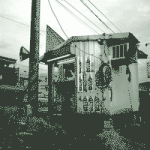
“A black bloc is a name given to groups of protesters who wear black clothing, scarves, sunglasses, ski masks, motorcycle helmets with padding, or other face-concealing and face-protecting items. The clothing is used to conceal marchers’ identities, and hinder criminal prosecution, by making it difficult to distinguish between participants. It is also used to protect their faces and eyes from items such as pepper-spray which law enforcement often uses. The tactic allows the group to appear as one large unified mass. Black bloc participants are often associated with anarchism.
The tactic was developed in the 1980s in the European autonomist movement’s protests against squatter evictions, nuclear power and restrictions on abortion, as well as other influences. Black blocs gained broader media attention outside Europe during the 1999 Seattle WTO protests, when a black bloc damaged property of GAP, Starbucks, Old Navy, and other multinational retail locations in downtown Seattle…”
from://en.wikipedia.org/wiki/Black_bloc
Montpelier, Vermont – Established in 2000, in a cooperative household located at the termination of a wooded dirt road in Southern Vermont, the Green Mountain Anarchist Collective (GMAC), for a time, did its part in carrying forth Vermont’s long tradition of radical, leftist politics. Founded in Windham County by Natasha Voline, Johnny Midnight, Xavier Massot, and (myself) David Van Deusen, the collective was birthed with strong Situationist, leftist, and militant inclinations. The original GMAC nucleus lived together (along with comrades Imelda R, Bridget M, and Ted K), and operated as a kind of outlaw community, connected to the broader area counter culture based in and around Brattleboro. Together, they functioned on a cash & barter basis, opening phone and utility accounts under assumed names. They adorned the walls with stolen Salvador Dali works. Torr Skoog and Liam Crill, of the Boston band The Kings of Nuthin [who Massot befriended shortly after he emigrated from his native France], were occasional visitors. Half of the household’s income came from the black market, the rest from a single student loan and occasional manual labor [once being paid to build a bird aviary for Kermit W –the rumored son of Egypt’s Nasser]. One household member was wanted by the law (facing some years in prison); another was an artist; two were brought up in strong union households; a few experimented in poetry; the household included two guitars and a five piece drum set in the living room. All present shared an interest in furthering a more creative, life affirming, and non-capitalist future. When not cutting their-own wood to feed the stove (which was typically the case), they “borrowed” a half cord at a time from unoccupied vacation homes scattered throughout the area. Trips to town often involved beer at the Common Ground (a co-op founded by local communes in the 1970s), or $5.40 double whiskeys at Mike’s (a rough-around-the-edges working class tavern on Elliot Street). However, town, being 15 miles away, largely remained un-visited. Instead, target shooting off the back porch with .22’s & SKS’s, making firecrackers out of black powder, listening to The Clash & Johnny Cash, trying to get a half junked 56’ Chevy working, long conversations, chess, strong marijuana (very strong marijuana), vigorous debate, and intensively reading from the Situationist, Existentialist, Anarchist, and Marxist cannons filled the time until a more direct political involvement came to be…
To recognize that a small insular collective, alone, is incapable of throwing off the chains of social/cultural and economic oppression is to come to one of three conclusions; 1. Revolution is in fact impossible, 2. A uniquely new mass movement must be built from the ground up, or 3. Revolutionaries must work with those mass organizations already in existence in order to influence a left turn in their direction. The Green Mountain Anarchist Collective rejected the first of these conclusions out of hand, finding history to tell a different story. GMAC then sought to synthesize the second and third of these conclusions into concerted series of actions. In short, GMAC worked with existing organizations, where possible, to build new expressions of class struggle which would be more grounded in anarchist principles than its parent groups; ie the support for the Dairy Farmers of Vermont and Montpelier Downtown Workers Union [although it could be argued that the Vermont Workers Center, excluding the question of Black Blocs, was as far left as GMAC]. And finally, GMAC saw no compelling reason not to work with existing mass organizations in a defensive capacity aimed at overcoming further attacks of capitalist and reactionary interest against working people; ie its collaboration with the ISO and SVR in opposition to the Minutemen, and organized labor against acute attacks of the boss against workers (and in favor of a withdrawal of U.S. troops from foreign occupations)…
from://news.infoshop.org/anarchist-news/rise-and-fall-green-mountain-anarchist-collective

























